
The Shift Toward Apartments in San Diego's Housing Market
In the San Diego housing landscape, a noteworthy trend has emerged: apartments now make up nearly 60% of all new home constructions in San Diego County from 2018 to 2024. This data, surfaced from a thorough investigation by Voice of San Diego in collaboration with KPBS, has sparked a conversation among residents about the implications of such a dominant trend in housing types.
Understanding the Challenges of Modern Housing
While the influx of new apartment units might seem like positive news to those concerned about the housing shortage, the reality proves more complicated. Accessory Dwelling Units (ADUs) follow, contributing around 17% to the new constructions. However, the type of housing being built raises critical concerns. Most of the new apartment units are oriented towards singles and couples, offering predominantly one-bedroom or studio options. This results in a mismatch between supply and the demographic needs of working families seeking larger residences.
Families Face Housing Crisis: The Missing 2- and 3-Bedroom Units
Gary London, a reputable real estate adviser, underlines the core issue: the inability to construct adequate housing for families is the driving force behind San Diego's housing crisis. Working families often require 2- and 3-bedroom units, without which they have no choice but to leave the city. This displacement potentially drains San Diego of its workforce, leading to long-term socioeconomic impacts.
What Does This Mean for San Diego's Future?
The lack of diverse housing options is not just a local concern but resonates on a broader scale. As the city continues to build primarily apartments and limited ADUs, a pattern of urban development that neglects family needs may emerge. This could create an unsustainable environment where only certain segments of the population can afford to live. As vacancies increase among apartments not suited for families, local leaders may be compelled to rethink their housing strategies.
Community Perspectives
Feedback from the community is essential in shaping future housing developments. San Diego residents have expressed varying views on how to navigate this situation - some emphasize immediate housing needs while others advocate for long-term solutions that create sustainable communities.
Looking at Potential Solutions
There is hope for recovery through bolstered policy initiatives aimed at increasing the production of diverse housing types. For instance, inclusionary zoning laws, which mandate a percentage of new housing to be affordable for families, could bridge the gap between the current offerings and the needs of the community. Additionally, transforming some existing apartment complexes to include larger units or converting under-utilized properties into family-friendly accommodations can also play a role.
Conclusion: The Call for Action
As San Diego grapples with its unique housing crisis, residents, policymakers, and developers must work together to ensure families are included in future housing initiatives. It’s crucial for communities to advocate for diverse housing that meets the needs of all residents. Engaging in discussions about what future construction should entail is imperative.
 Add Row
Add Row  Add
Add 




Write A Comment